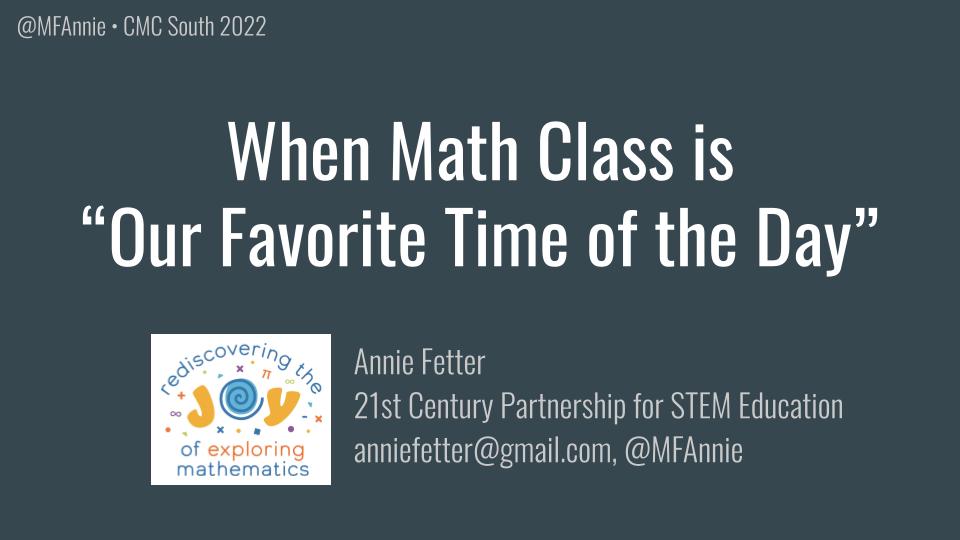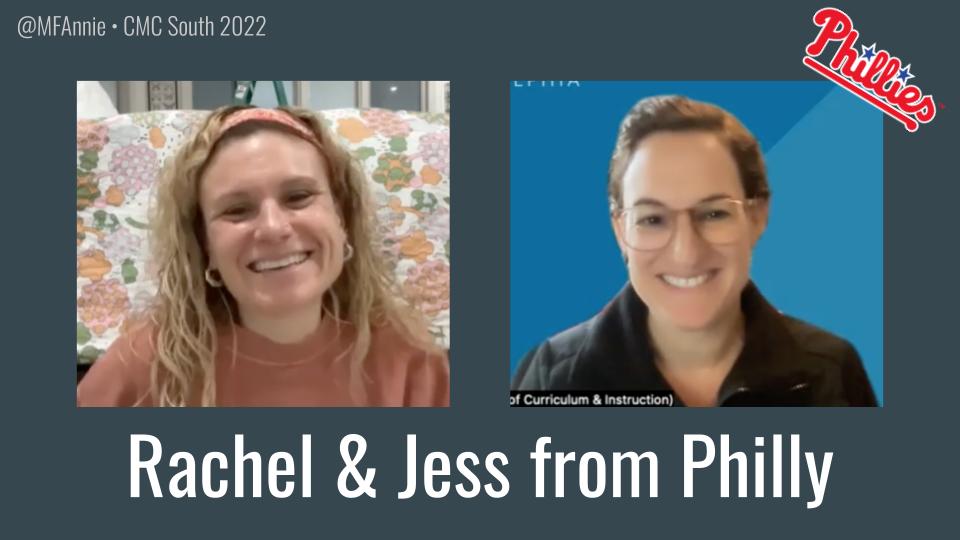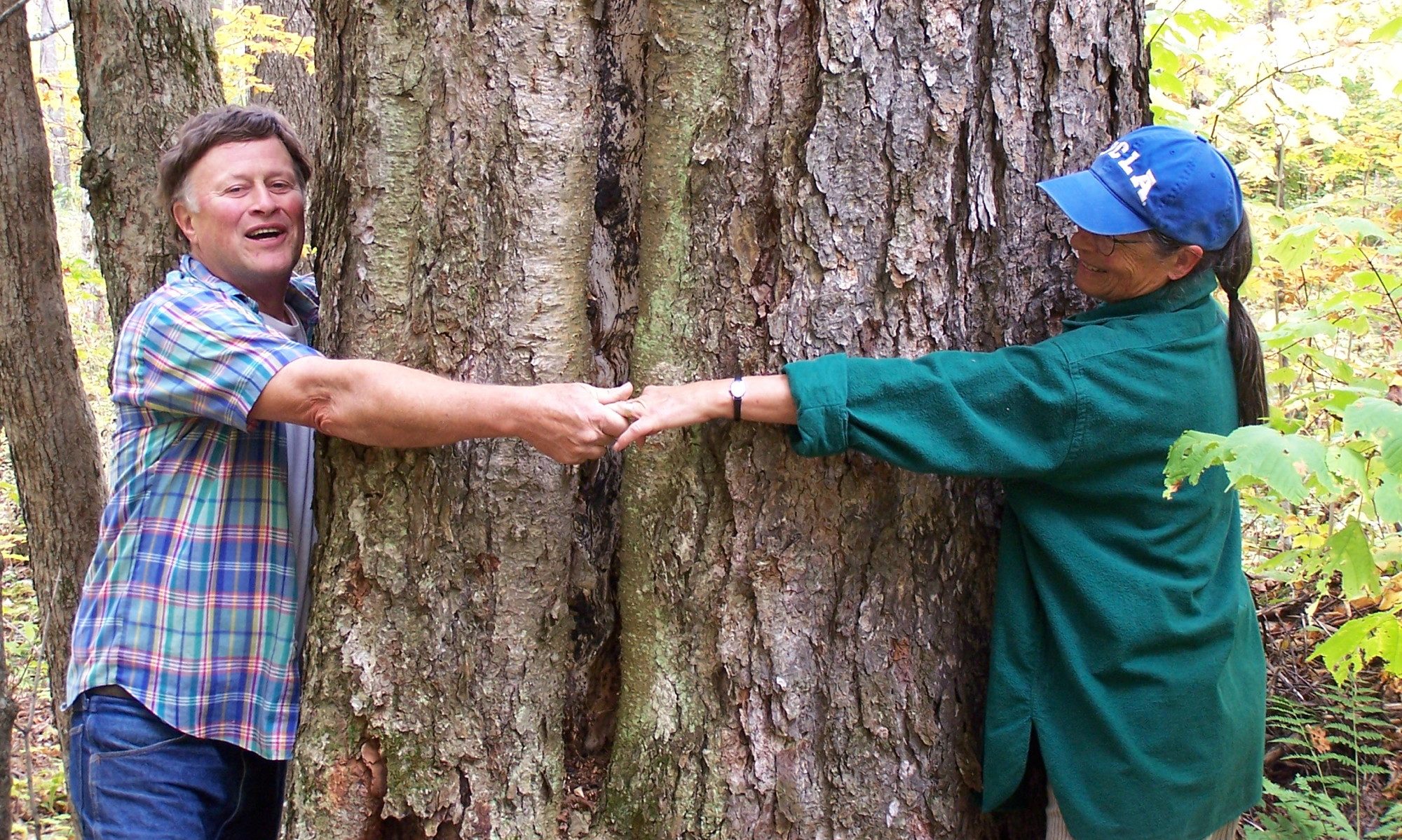
It was an honor, not to mention a whole lot of fun, to kick off CMC-South 2022 by presenting one of the two keynotes. If you were there, you might find my Google slide deck a helpful reminder – it even includes the video clips with Rachel, Jess, Cindy, and Melynee that speak more poignantly about the importance of focusing on students as people who have valuable thoughts than I ever could.
(Reminder: I used Google slides instead of my usual Apple Keynote because it could do closed captioning on the fly.)
If you weren’t there, I still want you to see these clips, and my “co-speakers” graciously gave me permission to share them with everyone.
The main goal I had for my session was to talk about how we find joy in actively doing things in spaces where we feel welcomed and valued.

I met Rachel Israelite and Jess Tilli in October of 2020 when I was looking for some classrooms in which I could teach model lessons for the McGraw Hill textbook series I’m an author on, Reveal Math K-5. Jess offered classrooms at the school where she had been a teacher leader. She’d led a strong school-wide push to incorporate sense making into teaching and learning math which had been underway for about three years. By way of introducing me to the school, she invited me to come visit Rachel’s second grade class – super easy to do, since it was early in the pandemic and Philly schools were meeting on Zoom.
Long story short, we ended up recording me teaching model lessons in a fourth grade class and Rachel teaching her second graders (all on Zoom).
After one of the recording sessions, we were talking to Rachel about their focus on sense making and what that felt like and she excitedly said, “Math is our favorite time of the day. For us, math is joyous!”
When I got invited to do this keynote for a conference whose theme was “Rediscovering the Joy of Exploring Mathematics”, I instantly thought of Rachel! She had moved to Kansas over the summer and when we recorded our conversation on Sunday, October 30, she had just gotten her Kansas teaching certificate and was going to start teaching first grade two days later. In this clip, she talks about why math was her class’s favorite time of the day.
Jess was a middle school math and science teacher and then a teacher leader (and Presidential Awardee for Excellence in Math and Science Teaching) at Rachel’s school (which is K-8), but had just moved to a position with the school district when she volunteered Rachel’s school for my lesson recording project. She’s now a district math curriculum specialist and is focused on helping teachers incorporate regular sense making activities into their math block. In this clip, she talks about giving teachers an opportunity to experience a sense making routine, and then having a conversation with them about how that actually “felt”.
Cindy Cliche is the Coordinator of Math for the Murfreesboro City School in Tennessee. I’ve known her since about 2015, when The Math Forum joined NCTM and I was added to a committee that she served on. Cindy also volunteered classrooms in her district for my model lesson recording project.
Her district has been focused on incorporating more sense making and has a motto of “Access, Agency, and Engagement” as they work to give more students a chance to feel welcomed in the math classroom. During Pandemic Summer, they used the Math for Love curriculum for summer school, and Cindy found that teachers would stop her in the hallway and say, “Why can’t math be like this all year?” In this clip, she talks about the goals of the curriculum and the shifts that using that curriculum has caused in her teachers. (The “he” she refers to is Dan Finkel, the founder of Math For Love.)
In this clip, a teacher from one of Cindy’s schools talks about the engagement she sees with the curriculum, and a student talks about things she likes about math.
What’s particularly lovely about the student’s statement is that she brings up “challenge” and “choice” when she’s doing math – she can make problems harder by using bigger numbers, and she can solve problems in as many different ways as she wants.
One day Cindy visited a first grade classroom that was doing some Noticing and Wondering and a boy called her over and whispered, “See that purple? That’s MY thinking!” This clip is after I reminded her about “Purple Boy”.
My final co-speaker was my friend Melynee Naegele from Oklahoma. You may know her as the organizer of #ElemMathChat on Twitter. By day, she’s currently a Grades 6-8 math interventionist in Claremore Public Schools in Oklahoma. Melynee starts her year with “Unit Zero” – activities and routines designed to foster community and good mathematical habits of mind. In this clip, I asked her what’s up with the fact that most of her students actually like being in her classroom.
I asked Melynee what brings joy to students in her classroom, and she shared a story that had just happened that day about making connections for students.
I was talking about Numberless Word Problems, and shared this problem I’d used with a first grade class in one of my recorded lessons:
Some apples are on a tree.
A horse eats some apples.
Some apples are left on the tree.
I had talked about how all the students made sense of the structure of the story, and then proceeded to make up increasingly elaborate stories that all shared the same structure. Rachel interjected with these thoughts:
Using sense making routines means that teachers deal with a lot of student ideas! Rachel talked a bit about how to make sure as many of those ideas as possible get heard and honored.
In this clip, Jess talks about encouraging a community of listeners, which greatly leverages all the awesome ideas that kids share.
Melynee tells the story of a student who uses Noticing and Wondering to solve the biggest problem in his life – and it’s not math. If you don’t tear up, you’re not human!
And in the “advice to teachers who haven’t yet used sense making routine into their math block”, we have two clips from Rachel (and a guest appearance from the puppy!).
On the one hand, you had to be there to see how these clips were woven into my narrative, but hopefully they’ll provide some inspiration, ideas, and even fodder for conversation in your PLC. Once again, my profound thanks to Rachel, Jess, Cindy, and Melynee for spending some time with me, sharing a bit of themselves with all of us, and truly believing that all students have mathematical ideas worth sharing and talking about. I’m incredibly fortunate to be able to hang out with such awesome educators!
